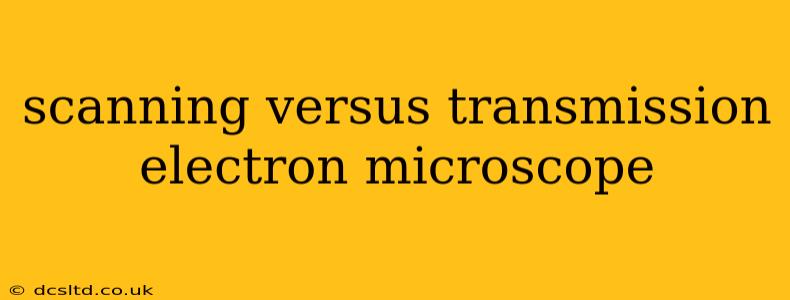Electron microscopes are indispensable tools in various scientific fields, offering unparalleled magnification capabilities far exceeding those of traditional light microscopes. However, there are two primary types: Scanning Electron Microscopes (SEMs) and Transmission Electron Microscopes (TEMs), each with unique strengths and applications. This comprehensive guide will delve into the key differences between SEMs and TEMs, helping you understand which type is best suited for your specific research needs.
What is a Scanning Electron Microscope (SEM)?
A Scanning Electron Microscope uses a focused beam of electrons to scan the surface of a sample. The interaction of the electrons with the sample produces various signals, including secondary electrons, which are detected to create an image. This process provides incredibly detailed, high-resolution images of the sample's surface topography, revealing intricate three-dimensional structures.
Advantages of SEM:
- High-resolution surface imaging: SEM excels at visualizing surface details, textures, and structures.
- Large depth of field: This allows for a greater portion of the sample to be in focus simultaneously, crucial for examining uneven surfaces.
- Sample preparation is relatively simple: While preparation is still necessary, it's generally less complex and time-consuming than for TEM.
- Can image a wide range of samples: SEMs can image both conductive and non-conductive materials, although non-conductive samples often require coating.
Disadvantages of SEM:
- Lower resolution than TEM: While offering excellent resolution, SEM's resolution is not as high as that achieved by TEM.
- Only surface information: SEM primarily provides information about the sample's surface; internal structures are not directly visualized.
- Vacuum environment required: The imaging process necessitates a high vacuum environment.
- Electron beam damage: The electron beam can potentially damage sensitive samples.
What is a Transmission Electron Microscope (TEM)?
A Transmission Electron Microscope transmits a beam of electrons through an extremely thin sample. The electrons that pass through the sample interact with its internal structures, creating an image based on the differential scattering of electrons. This allows for visualization of internal structures at an extremely high resolution.
Advantages of TEM:
- Highest resolution imaging: TEM offers the highest resolution of any microscopy technique, allowing for the visualization of individual atoms in certain cases.
- Internal structure visualization: TEM provides detailed information about the sample's internal structure and composition.
- Elemental analysis capabilities: TEM can be coupled with techniques like energy-dispersive X-ray spectroscopy (EDS) to determine the elemental composition of the sample.
Disadvantages of TEM:
- Sample preparation is demanding: TEM requires extremely thin samples (often nanometers in thickness), necessitating complex and time-consuming preparation techniques.
- High vacuum environment required: Similar to SEM, TEM imaging needs a high vacuum environment.
- Electron beam damage: The high-energy electron beam can potentially damage sensitive samples.
- Limited depth of field: Compared to SEM, TEM has a shallower depth of field.
SEM vs. TEM: Key Differences Summarized
| Feature | SEM | TEM |
|---|---|---|
| Imaging Type | Surface imaging | Transmission imaging |
| Resolution | High, but lower than TEM | Highest resolution available |
| Sample Prep | Relatively simple | Very complex and demanding |
| Depth of Field | Large | Small |
| Information | Surface topography, composition (EDS) | Internal structure, composition (EDS) |
What type of microscope is best for my research?
The choice between SEM and TEM depends entirely on the nature of your research question and the type of information you seek. If you need high-resolution surface imaging with a large depth of field and relatively simple sample preparation, SEM is likely the better choice. If you require the highest possible resolution to visualize internal structures and conduct elemental analysis, then TEM is necessary, despite the more demanding sample preparation.
What are the different types of electron microscopy?
This is a broad question and covers more than just SEM and TEM. Beyond these two main types, there are specialized techniques like:
- Cryo-SEM (Cryo-Scanning Electron Microscopy): Used for imaging hydrated samples, including biological specimens.
- Environmental SEM (ESEM): Allows imaging of samples in a less high-vacuum or even wet conditions.
- Scanning Transmission Electron Microscopy (STEM): A technique that combines aspects of SEM and TEM.
- Low-Voltage Electron Microscopy: Uses lower accelerating voltages to reduce beam damage to sensitive samples.
Understanding the nuances of each technique is critical for choosing the appropriate method for your specific research needs. Careful consideration of sample type, desired resolution, and the type of information sought will lead to the most effective use of electron microscopy.
